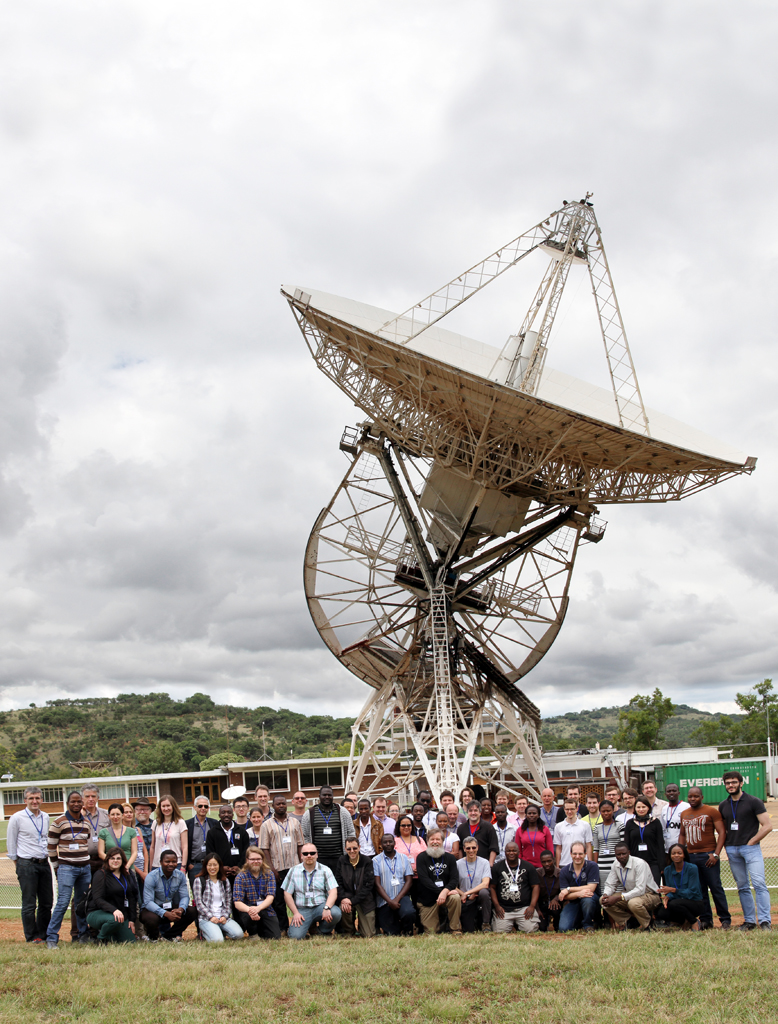IVS School on Very Long Baseline Interferometry

2nd IVS Training School on VLBI for Geodesy and Astrometry – Frank Lemoine, NASA Goddard Space Flight Center
The IVS organized its 2nd training school at the Hartebeesthoek Radio Astronomy Observatory (HartRAO), South Africa, 9‒12 March 2016. The purpose of the training school was to help prepare the next generation of researchers to understand VLBI systems and inspire them in their future careers. The 45 participants included 32 students from institutions in different countries in Africa and Asia, Europe, and North America as well as 13 professionals (including postdocs) from the VLBI community and other fields of space geodesy. Participants came from Kenya (10), Zambia (9), Germany (7), Austria (4), U.S.A. (4), China (2), Finland (2), France (2), Sweden (2), Ghana (1), Italy (1), and Spain (1). Students were enrolled in M.S. and Ph.D. programs, involved in the use and analysis of VLBI data, and indeed some were second-time VLBI school attendees. Some professionals came from space agencies or geodetic research institutes (ASI, BKG, CNES, NASA) with a view to integrating VLBI into a combined analysis of space-geodetic data. A large group of attendees included students from different countries in Africa with the aim to develop expertise in geodesy and especially VLBI as part of an effort to build new stations in Africa and integrate them into the global VLBI network. We all hope this effort will come to fruition, because it will enhance the accuracy and strength of the geodetic technique and bring new groups and new countries into the VLBI community.
The thirteen lectures (18 hours and 45 minutes over four days) covered the general theory of VLBI, the technical equipment of the stations, data acquisition, data formats and data transfer, experiment scheduling and actually observing an experiment, the use of correlators, and post-correlator analysis, an introduction to geophysical modeling and analysis of VLBI data, the characterization of radio sources, and the development of celestial reference frames. The lectures were complemented with exercises on some of the presentation topics—so the participants had a chance to apply what they had been shown. The lecturers obviously spent a lot of time preparing their presentations and lectures which was highly appreciated. The lectures were recorded and will be made available on the Web, so they will be an invaluable resource for the attendees to review in coming weeks and months. For many of the attendees, the most exciting part of the VLBI school was to run the “sked” software to schedule a VLBI experiment involving Hartebeesthoek and Wettzell, and then watch Alexander Neidhardt remotely operate the Wettzell telescope via his laptop in the room with the class in South Africa, while the HartRAO 26-m (visible right outside the windows of the classroom) moved in tandem to observe the same radio sources. It gave all the attendees a demonstrable and clear sense of participation and understanding of how VLBI data are acquired.
For all the attendees at the school, the retreat format with the abundant time for interaction and discussion during the class and the coffee breaks were especially useful. It’s much easier to approach people with questions in this type of retreat format, than in a crowded conference setting such as the EGU or the AGU with their tsunami wave of attendees (10,000‒20,000 people). As a senior researcher, I found the contact and presence of the many students to be invigorating. It bodes well for the future of the discipline.
All the attendees appreciated the organization by school organizers and lecturers, and especially by the HartRAO observatory. HartRAO prepared a room with PCs where everyone could follow directly the presentations, search for reference material on the Web, or run the programs involved in the class exercises. This is a recipe that should be followed for future VLBI schools if at all possible. In the evening of the last day, after the end of astronomical twilight, the northern hemisphere attendees had the pleasure of contemplating Alpha and Beta Centauri as well as the Southern Cross in a setting devoid of light pollution, crowning a truly memorable week.
Acknowledgement. The 2nd IVS Training School was supported by HartRAO (e.g., by providing the lecture room, transportation, coffee, lunches & barbecue). MT Mechatronics (Mainz, Germany), Hat-Lab (an Istituto Nazionale di Astrofisica spin-off company), and Callisto (France/UK space communications company) provided financial support allowing the actual student participants of the school to receive a travel grant in the amount of 2900 ZAR.
[Photo caption: http://www.evga.org/IVS_school_2016.jpg] Attendees of the IVS Training School in front of the HartRAO 26-m radio telescope.
[Photo caption: iag_newsletter_may16_VLBIschool_IMG_2791.jpeg] In the classroom during a VLBI school exercise